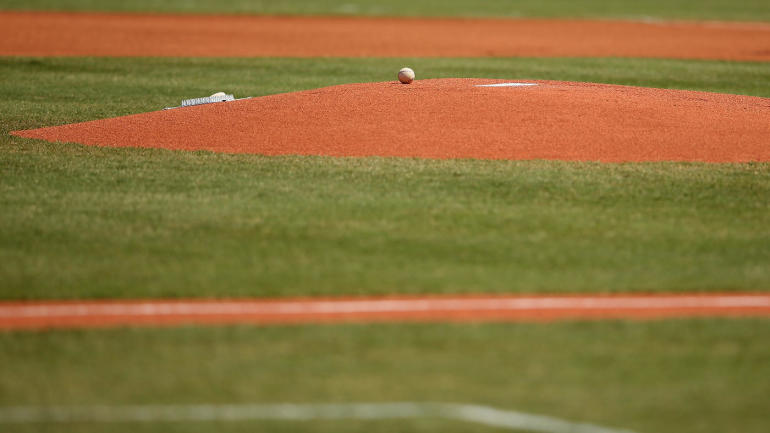
The Atlantic League, an eight-team independent partner league of Major League Baseball, will experiment with moving the pitcher's mound back 12 inches in 2021, the leagues announced Wednesday. The Atlantic League will also test a "double hook" rule in which the DH is tied to the starting pitcher. Once the starter is removed from the game, the team loses the DH.
MLB has partnered with the Atlantic League to test various rule changes in recent years, including the automated strike zone in 2019.
"Fans, players and many others in the baseball community have expressed an interest in seeing more regular action on the field," MLB consultant Theo Epstein said in a statement. "Therefore, it's important that we use the 2021 season to explore various ways to create more frequent contact -- and the increased action and athleticism on display that will follow. We are grateful that the Atlantic League -- which has been at the forefront of successful rule experiments in the past -- has agreed to test a 12-inch increase in the distance between the pitching rubber and home plate during the second half of the season. We expect to learn a great deal about the impacts of such a change and whether an adjustment to this critical field dimension is worth potential future consideration at other levels of professional baseball."
Atlantic League president Rick White added: "We are pleased to play a critical role in Major League Baseball's tests and evaluation of experimental rules. The ALPB is a forward-thinking league, and it is satisfying to our teams and players to be leaders determining the future of our sport. We are proud to play our part conducting MLB trials and excited to see the results of the potential changes."
In theory, moving the mound back a bit gives the hitter that much more time to read the pitch and react, and thus more time to make contact. More contact equals more balls in play and thus more action. There's also the potential for unintended consequences, like an increase in walk rate as pitchers struggle to locate now that they're further away from the plate.
Strikeout and home run rates continue to explode, and fewer balls are bring in put in play with each passing year. So far this MLB season, 37.1 percent of all plate appearances have ended in a strikeout, walk, or home run. It was 36.0 percent last year and 35.1 percent the year before that. It was 29.2 percent a decade ago. That's a lot of plate appearances without a lot of action.
The Atlantic League planned to move the mound back two feet in 2019, but opted against it after receiving pushback from several players, including former MLB players who threatened to leave the league. There has been no change to the pitching mound dimensions in professional baseball, MLB or otherwise, since the mound was lowered in 1969.
Here's what MLB says about the potential injury risk associated with moving the mound back to 61 feet, 6 inches:
This change was also determined to be safe, as it does not require the pitcher to alter pitching mechanics and there is no evidence of increased injury risk. The American Sports Medicine Institute ("ASMI") conducted a study in October of 2019 that measured the impact of pitching distance on biomechanics. In the study, high-level collegiate baseball players threw from distances of 60'6", 62'6", and 63'8". No significant differences in key measures of rotational motion (kinetics) or acceleration (kinematics) were observed among the varying pitching distances. In addition, ball velocity and strike percentage remained consistent.
I don't know whether moving the mound back 12 inches is the correct answer. Maybe it's six inches or nine inches or 10.75 inches. I do think it is a worthwhile experiment though. The league strikeout rate continues to climb and with pitchers throwing harder and with nastier secondary pitches than ever, something has to be done to combat that. The strikeout rate will continue climbing otherwise.
As for the "double hook" rule, that feels like a solution in search of a problem. It would disincentivize teams from using openers, and I think that's a plus, but we'd be taking the bat out of the hands of some very good hitters. Baseball doesn't need more pinch-hitters or more double switches or more "strategy." It needs its best players on the field showcasing their skills. This doesn't do that.
MLB will study the results in the Atlantic League this year and, if they like what they'll see from the new mound and/or the "double hook" rule, they'll presumably move on to testing those rules in the minors. They won't bring them right to MLB, and besides, the MLBPA would have to agree to any rule changes. At a time of great labor discord, that won't be an easy sell.


















